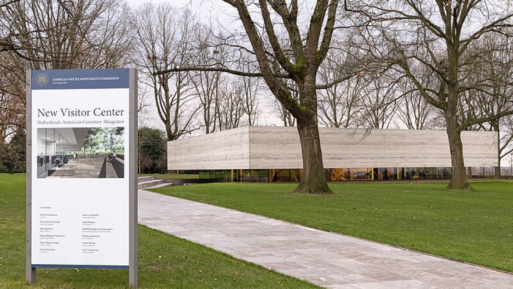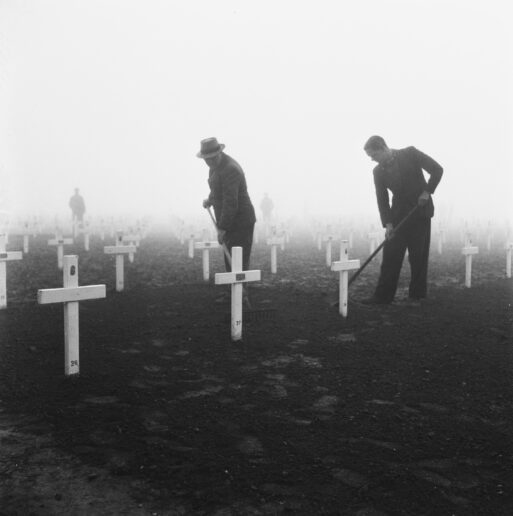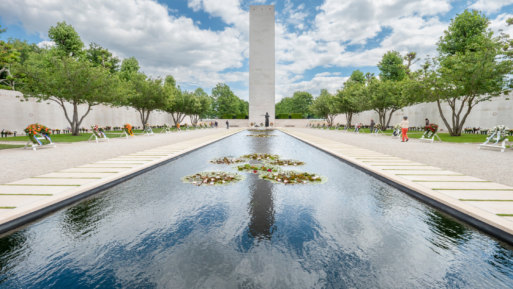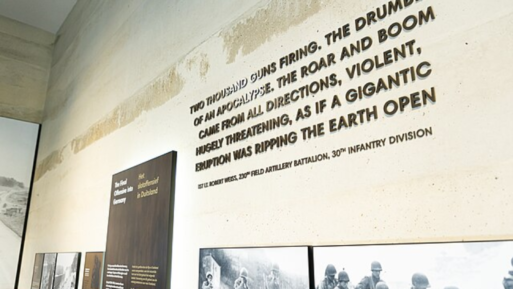
In the southernmost region of the Netherlands, in the village of Margraten, is a cemetery dedicated to American soldiers who died in World War II. Originally built as a temporary repository for war dead in the waning days of 1944, so that no Americans would remain buried in enemy territory, the memorial has since become an emblem of the relationship between the two countries. Recently, the cemetery unveiled its new Visitor Center.
History of the Cemetery and Memorial
The cemetery was commissioned in November of 1944, as the Ninth U.S. Army pushed into the Netherlands from France and Belgium. The leadership of Margraten village worked with Lt. Col. Joseph Shomon’s 611th Graves Registration Company to build a cemetery that would serve as a temporary grave site for any soldiers who died within a 600-kilometer radius.
Ground was broken with the labor of the largely African American 960th Quartermaster Corps during Thanksgiving of 1944. In what was to be a historically cold and wet winter for the Netherlands, troops struggled to properly inter the bodies, battling frozen corpses and flooded gravesites. The spring brought better conditions, but more dead: the Battle of the Bulge, which was being fought nearby, forced the U.S. military to turn to the people of Margraten for help. The response of the village was extraordinary, and marked the beginning of a unique bond that is still shared today.

Two men work together at Margraten gravesite in 1945.
Credit: Nationaal Archief: Fotocollectie Anefo Reportage
Initially, the cemetery accommodated over 20,000 bodies (including those of enemy forces) from the last months of the conflict. Ultimately, as permanent cemeteries were opened and bodies were returned to their home countries, the cemetery became the final resting place for over 8,000 American soldiers who died during the waning days of WWII.
Grave Adoption
When the U.S. Military turned to the village of Margraten for help, their response was remarkable. The construction, deconstruction, and reconstruction of the cemetery was only made possible by the village’s active participation. Since 1945, members of the local community have “adopted” the gravesites, taking it upon themselves to bring flowers and research the life of the service members as a way to honor their sacrifice. Many of the adoptions are passed down through generations of families, cementing the bond between the two nations. (For more information, the adoption program is administered by the Foundation for Adopting Graves American Cemetery Margraten.)
The American Cemetery Site

The reflection pool surrounded by the Tablets of the Missing
Even before reaching the site, which covers over 65 acres, the cemetery’s tall memorial tower can be seen ascending into the sky. From the cemetery entrance, visitors are led to the Court of Honor, where a reflection pool mirrors the monument. Stretching along the sides of the court are the Tablets of the Missing, which display 1,722 names of WWII soldiers. Rosettes mark the names of those since recovered and identified. Beyond the tower, one can see the burial area divided into 16 plots, where over 8,000 military dead rest under headstones set in long curves. A wide, tree-lined mall leads to the flagstaff that sits upon a gentle crest in the carefully maintained landscape.
At the base of the tower facing the reflecting pool is a statue that pays homage to women who have suffered loss during wartime. Flanking the tower is the map room – which contains three large, engraved operation maps with texts depicting U.S. military operations – and the newly designed visitor’s center.
KAAN Archichten’s New Visitor Center
Completed in 2023, KAAN Architechten’s Visitor Center is strategically central, yet isolated to preserve the site’s peaceful atmosphere. Sunken into a natural depression in the landscape, the floor of the center is below ground level but surrounded by glass walls, providing a unique perspective for viewing the burial area beyond.
 The exhibition spaces within the visitor center feature original artifacts and personal stories of some of the soldiers who fought and died in Europe during World War II. Just outside the glass walls are concrete benches and a minimalistic seating area, encouraging guests to take the time for peaceful contemplation. Overhead, a floating concrete fascia defies scale perception; it narrows the visual focus of anyone looking out, almost forcing a panoramic perspective.
The exhibition spaces within the visitor center feature original artifacts and personal stories of some of the soldiers who fought and died in Europe during World War II. Just outside the glass walls are concrete benches and a minimalistic seating area, encouraging guests to take the time for peaceful contemplation. Overhead, a floating concrete fascia defies scale perception; it narrows the visual focus of anyone looking out, almost forcing a panoramic perspective.
When visiting the center, it is clear that a lot of thought and energy was invested in ensuring that the new edifice added to the site without drawing attention away from the central objective – to honor the American dead who still reside on friendly-but-foreign soil.

 KAAN Architecten’s New Visitor Center at the Netherlands American Cemetery
KAAN Architecten’s New Visitor Center at the Netherlands American Cemetery


 National Donate Life Month Reminds Us To Give
National Donate Life Month Reminds Us To Give
 How Dare You Die Now!
How Dare You Die Now!
 Debating Medical Aid in Dying
Debating Medical Aid in Dying














